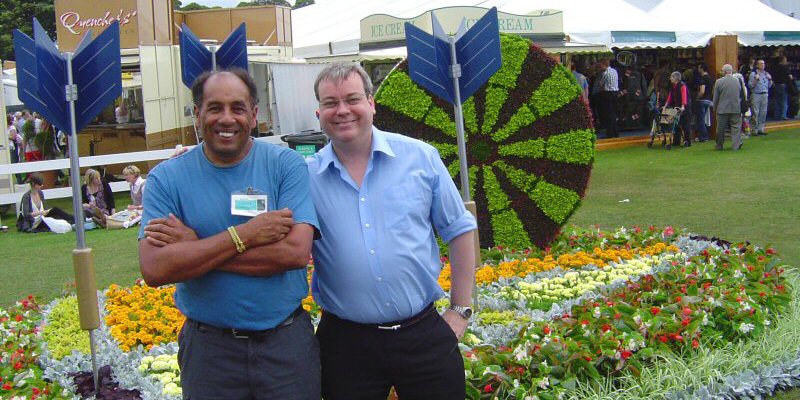Factoids |
F The number system on the board is often credited to Brian Gamlin, a carpenter from Bury, Lancashire, who is said to have invented it at the age of 44 in 1896 but he died in 1903 without patenting it. But alas after extensive research viewing the English and Wales Census no trace of Brian's existence can be found. This is not to say he didn't exist, as some reports say that Brian was also attached to a travelling circus and may have missed the census at the time.
According to another source, Thomas William Buckle invented the dartboard in 1913. The source in question is his son, Thomas Edward Buckle, who made this statement in Darts World Magazine 1992 (issue 234).

Kevin Price from Bury Council & David King at Tatton Park
In 2009 the Council Bury Lancashire entry into Royal Horticultural Society 'Tatton Park's National Flowerbed Competition' was inspired by Brian Gamlin the man credited with the modern dartboard numbering sequence. The title of the display being' A tribute to Brian Gamlin' To read more about the dartboard numbering system and Bury Councils flower display click here
F In 1908 the Magistrates made a decision in Leeds, England which effectively ensured the eventual popularity of darts as a sport. At that time, "games of chance" were illegal in public houses (pubs). A pub owner called "Foot" Anakin was accused of operating a game of chance and prosecuted for allowing darts at his establishment. Foot argued that darts was not a game of chance, and obtained permission for a dartboard to be set up in the courtroom. It is said that Anakin threw three darts in the 20 and invited any magistrate to do the same. The challenge was accepted; however, the court officials were unable to duplicate Foot's shot, thus proving darts was indeed a game of skill and not of chance. The case was dismissed.

F Did you know the length of a dart can not exceed an overall length of 30.5 cm (12ins) nor weigh more than 50 grams. No rules on the length of your moustache!
F The most commonly used dartboards are known as bristle boards, but they are in fact made from compressed sisal a material used in rope making. Not pig or horse bristle that some like to believe.
F In 1978 Leighton Rees from Wales became the first World Darts Champion. He received a trophy and a cheque for £3,000. In 2020 Peter Wright won the PDC World Darts Championship and received a trophy and a cheque for £500,000.
F John Lowe from England recorded the first televised nine-dart 501 leg in 1984 at the MFI World Match Play.
F The height of the dartboard is 5'8" to the centre of the bull, although there is no real evidence to establish why this height was chosen. It is believed that this was the average height of a man during the 1920s, and therefore this height was used.

F Why 501? Originally darts was played over 301. When darts was introduced to the public houses of Great Britain, there was no easy way of scoring a game, so a cribbage scoreboard (card game) was used. A cribbage board has 60 holes in it, and you score by moving a peg along the holes. You have to go around a cribbage board five times to score 300; however, to win a game of cribbage, you have to score an extra 1 thus 301.
F Why is the standard darts throwing distance set at 7'9 ¼"? When the British Darts Organisation (BDO) was set up in the 1970s, there were two recognised throwing distances. The National Darts Association (no longer in existence) used 7'6" and the News of the World darts championship 8'0". To compromise the BDO set a length of 7'9" but at this time the UK was becoming part of the European Union, and metric was being introduced; 7'9" didn't convert easily. Therefore the distance was extended to 7' 9 ¼" which is precisely 2.37m
F Did you know besides sisal, dartboards have been made from many different types of materials: various woods, paper and even clay!
F There are 62 scoring segments on a dartboard, and 238,328 possible scoring combinations are using three scoring darts.
F Where does the word Oche come from? 'Oche' as a word meaning the throwing line which a dart player stands behind to throw his or her darts is comparatively recent, being introduced by the British Darts Organisation in the mid-1970s. The actual word is believed to be derived from Old Flemish (or similar) meaning a notch or nick.
F Before then, the truth is that, since the 1920s, the word was 'Hockey' and not 'Oche' was used in competition rules. This word was used by the News of the World for their individual darts competitions from the late 1920s onwards. References to 'Hockey and Son' Brewery and the throwing distance being created by putting beer creates end to end has always been a nice theory but it is untrue. No such Brewery every existed in the UK
F Did you know darts is a recognised sport and not a game! Recognised as a sport by Sports England on the 25th March 2005.
Returns to Darts Resource
More at Factoids on Darts501.com